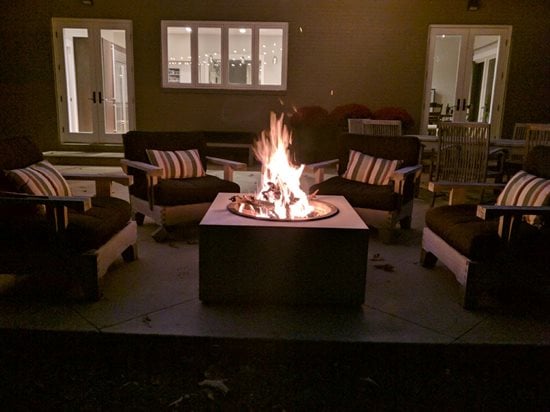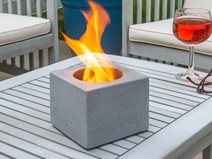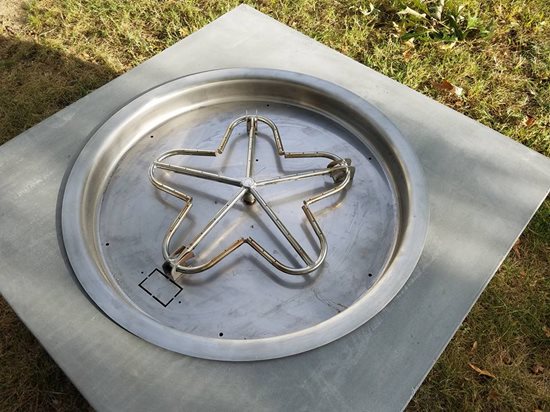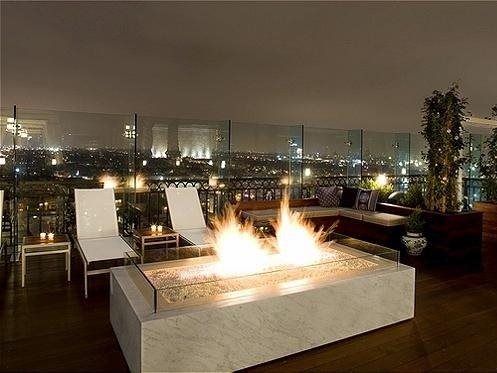- Outdoor Living Space Ideas
- Top trends in outdoor concrete design
- Outdoor room checklist (PDF)
- Fire Pit or Fireplace?
- Ways to Enhance Outdoor Rooms
- Outdoor fireplaces
- Fire pits
- Concrete fire bowls and tables
- Outdoor kitchens and countertops
- Seat walls
- Outdoor concrete furniture
- Concrete planters
- Backyard Landscaping with Concrete
- Concrete patios
- Concrete curbing
- Stairs and steps
- Concrete walkways
- Concrete garden bridges
- Water features
- Architectural accents
- Concrete statuary
- Backyard Landscaping: Get more ideas from LandscapingNetwork.com
- Backyard Recreation Options
- Concrete pool decks: Design and layout tips
- Concrete tennis courts: Planning and construction
- Other Resources
- Outdoor Decorative Floors
- Free Outdoor Living Catalog
Concrete Fire Bowls and Tables
Compare cast concrete fire bowls and fire tables, plus see what options are availableA precast concrete fire bowl or fire table is an easy, versatile way to extend the enjoyment of an outdoor living space throughout the year by providing warmth, light, and nighttime ambience. Compared with outdoor concrete fireplaces, these freestanding units can be installed more quickly, take up less space, and can even be combined with a water feature to create the ultimate outdoor experience.
Concrete Fire Bowl vs. Fire Table
While both styles offer similar benefits, there are important differences you should consider before installing one or the other. Here’s an overview of some of your options, along with tips for choosing the best fire feature for your space and budget.
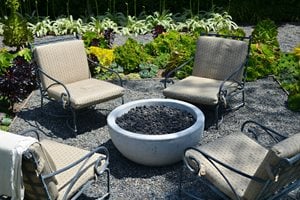
ConcreteNetwork.com
What is a Fire Bowl?
- Precast concrete fire bowls make a great alternative to a built-in concrete fire pit.
- They come in many sizes, including small bowls for tables or pillars and large bowls for gatherings.
- When cast using lightweight glass fiber reinforced concrete (GFRC) they can be moved easily.
- While most are round, you can also find modern square fire bowls or wok-shaped designs.
- Plus, the depth can range from shallow and broad to tall and tapered.
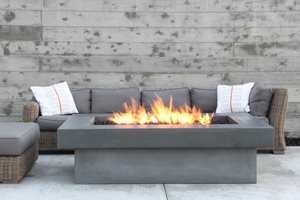
Concrete Wave Design in Anaheim, CA
What is a Fire Table?
- A concrete fire table does double duty as a source of warmth and as a surface for serving food.
- Their wide rims easily accommodate plates and glasses.
- When not in use you can convert the unit into a fully functional table with a cover.
- They come in rectangular or circular shapes and coffee table or dining table heights.
- They are usually too large to offer portability and are typically installed as permanent outdoor fixtures.
Making Your Own Concrete Fire Bowl
While most people find it convenient to order a premade concrete fire bowl, you can also have one custom made for your outdoor space, or even make one yourself using a fire bowl mold (see Fire Bowl Molds Add Zen-Appeal). If you choose to go custom, you will likely spend more, but you will have unlimited size, shape, finish, and color options.
Fuel: Gas vs. Wood
The type of fuel you burn in your concrete fire bowl or table can have a big impact on overall cost, safety, and heating efficiency. You have three options: wood, natural gas, or liquid propane. Each one has its pros and cons.
Wood-burning fire bowls and tables are a great choice if you want to create a campfire-like atmosphere, produce a lot of heat, and eliminate the expense of installing a gas line. However, because of the billowing smoke and flying embers they produce, they can be a health and fire hazard if not carefully monitored. In some high-risk communities, outdoor wood-burning fire features are not permitted.
A clean-burning natural gas fire bowl or table eliminates smoke, and the intensity of the flames is much easier to control. It will produce less heat than a wood fire (around 40,000 to 100,000 BTU) but will still provide enough warmth to make your outdoor space comfortable. The fire can also be started instantly, often at the push of a button. The biggest drawback is the expense, since you’ll need to install a gas line and buy a burner element for your unit.
The most economical way to fuel your fire is with a 20-pound propane tank – the same type you’d use with a typical propane grill. It doesn’t require an in-ground gas line, but you’ll have to refill or change the tank periodically. This heating option works best with a table-mounted fire bowl that allows you to hide the tank beneath the table.
Tabletop Fire Bowl
Keep the fun going with this tabletop concrete fire bowl from Caldera Fire Co! It’s perfect for creating ambiance indoors and out, and even for making s’mores!
- Burns isopropyl rubbing alcohol
- Made in the USA
- Dealer inquiries welcome
Filler: Lava Rock, Fire Glass & Other Options
Gas-fueled concrete fire bowls and tables can be filled with lava rock, colored fire glass, ceramic logs, or other fireproof decorative accents such as geometric stones and spheres. The material you choose often depends on your budget and personal tastes.
Lava rock or ceramic logs are a good filler choice if you prefer a more rustic appearance that complements the organic look of natural concrete. Fire glass costs nearly twice as much as lava rock, but its reflectivity enables it to give off more heat and it comes in a wide range of decorative colors. Another option is to combine fire glass with lava rock, using lava rock as the bottom layer and fire glass on top. This allows you to obtain the heating efficiency and shimmering visual effects of fire glass while cutting costs.
Choosing a Burner and Ignition System
The most important components of a gas-fueled concrete fire bowl or table are the burner and ignition system, which may be sold separately or together as a kit. It’s worth the extra expense to buy a system that’s reliable and long-lasting, but you can minimize your costs by sacrificing a bit of convenience.
A stainless steel fire ring is the most commonly used type and will usually give you the most bang for your buck. They provide many years of use at a reasonable price and substantially outlast cheaper galvanized steel burners. If you’re willing to pay a premium price, you can upgrade to a brass burner, which is the most durable option and will last indefinitely.
Ignition systems can range from basic match-lit systems to Bluetooth-enabled electronic ignition systems that you can operate with a smartphone. If you’re looking for value and reliability, a match-lit system is the most economical option. If you prefer the convenience of just pressing a button to light your burner, then an electronic system may be a better choice, but it will cost substantially more and requires access to an electrical outlet. A good middle-of-the road option is a spark ignition, which offers the push-button convenience of an electronic system but is battery powered so it doesn’t require electricity.
Safety Accessories
If you live in an area prone to high winds, consider installing a wind guard around your concrete fire bowl or table. These clear, tempered-glass shields not only help to block the wind, they also prevent children from getting too close to flames.
If your fire feature is fueled by natural gas, there are a number of automatic safety controls you can install to control gas flow and flame intensity, including flame sensors and automatic shutoff timers that attach directly to the gas line.
Keep in mind that although concrete is fireproof, the surface you set your fire bowl or table on may not be. If your fire feature is located on a wood deck, you will need to take extra safety precautions when using it. Get more fire pit safety tips.
Combining Fire and Water
One of the newest trends in concrete fire bowls is to combine the elements of fire and water so the flame appears to dance on the water's surface (see Playing with Fire). For more drama, you can place the bowl atop a pedestal, adding a scupper to allow the water to cascade into a pool or pond. The dancing flame combined with the soothing sound of flowing water is especially mesmerizing.

